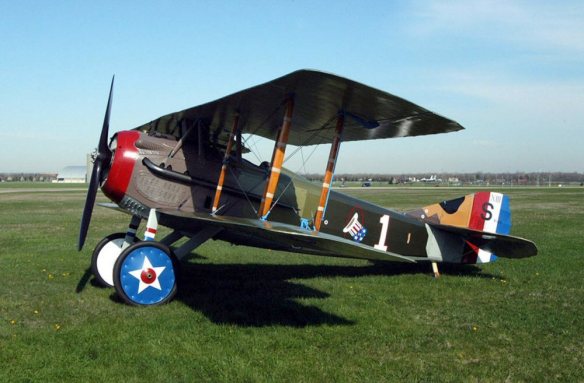The most famous of the US aircraft of World War I, and the one supplied in the largest quantities, the SPAD XIII was the logical development of a successful line of fighters. In combat it was sturdy, fast and hard-hitting, enabling the American fliers to compile an extensive victory list during the last hectic months of fighting. This patriotic aircraft was the mount of America’s greatest ace, Captain Edward Rickenbacker of the 94th Aero Squadron. Downing his first aircraft, an Albatros D. Va on 29 April 1918, he ran up the considerable score of 26 before the Armistice on 11 November that year.
With more than 6,500 examples built, the SPAD W could be regarded as a definite success and, not surprisingly, it was decided to develop the same basic design to produce a new single-seat fighter. In adopting such an approach at a period of time when a day saved would be of vital importance to the course of the air war, the company was able to lean upon’ the best features of the SPAD VIII, and gain enhanced performance from a combination of improvements and more power. Thus in basic combination there was little difference between the SPAD VII and the new version, which was given the designation SPAD XIII. Except for some structural reinforcement, the improvements were largely of an aerodynamic nature, with the wing span increased by 11 in (28 cm), the introduction of improved ailerons, an increase in the area of tail surfaces, plus other aerodynamic refinements that resulted largely from cleaning up the existing structure. A more powerful version of the Hispano-Suiza 8 engine was adopted and, in this form, the prototype was flown for the first time on 4 April 1917.
Test and evaluation of the prototype showed an improvement of some 18 per cent in maximum speed and a 19 per cent increase in ceiling, with the additional power making it possible to carry a second machine-gun yet retaining the excellent handling and maneuverability that had been the secret of the SPAD VIIs success. Orders flowed in from France’s allies, with initial deliveries starting at the beginning of June 1917. By the time that production ended a total of 8,472 had been built and orders outstanding for more than 10,000 aircraft were cancelled at the Armistice. AEF procurement of the SPAD XIII totalled 893, which was by far the largest number of any single type which the US Army acquired from any of its allies during World War I. The type eventually equipped 16 squadrons and the first was delivered in March 1918 to the 1st Pursuit Group, which comprised the 27th, 94th, 95th and the 147th Aero Squadrons based in the Toul Sector. SPAD XIIIs helped top American aces Eddie Rickenbacker, Frank Luke and Raoul Lufbery to reach their respective totals of 26,21 and 17 combat victories, but the type saw little more than five months’ front-line service before the Armistice brought an end to the fighting, and surviving SPAD XIIIs were shipped to the USA. There they were used for a short period as first-line fighters before they were relegated to a training role. Unreliability of the Hispano-Suiza engine hastened their withdrawal from service, but in 1922 a small number were reengined with a 180-hp (134-kW) direct-drive Wright E (licence-built Hispano-Suiza) to become redesignated the SPAD 13E.
Specification
SPAD XIII
Type: single-seat righter
Powerplant: one 220-hp (164-kW Hispano-Suiza 8Be Vee piston engine
Performance: maximum speed 139 mph (224 kmh) at 6,560 ft (2.000 m); climb to 13,125 R (4,000 m) in 12 minutes 30 seconds; service ceiling 21,815 ft (6,650 m); range 185 miles (298 km)
Weight: maximum take-off 1,863 Ib (845 kg)
Dimensions span 26 ft 6.9 in (8.1 m); length 20 ft 8 in (6.3 m); height 7 ft 8.5 in (2.35 m)
Armament: two fixed forward-firing synchronised 0.303-in (7.7- mml Vickers machine-guns
